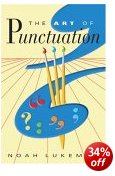sample from HTML program and PDF book
1. If you are in any doubt at all concerning the correct use of semicolons – then avoid using them entirely. They are the most commonly misused and misunderstood mark of punctuation.
2. It is perfectly possible to write clearly and effectively using only the comma and the full stop. Do this if you are in any doubt about the use of the semicolon (and the colon).
3. Remember that the semicolon represents a pause which is longer than a comma but shorter than a full stop (and a colon). It is normally used to separate clauses which could stand alone, but which are closely related.
4. It is used when the second clause expands or explains the first:
Neither of us spoke; we merely waited patiently in silence to see what would happen next.
5. It is used when the clauses describe a sequence of actions or different aspects of the same topic:
There was a sharp, bracing air; the ground beneath us was dry; the sea was calm and clear.
6. It is used before clauses which begin with ‘nevertheless’, ‘therefore’, ‘even so’, and ‘for instance’:
He usually took great care; even so he made a few errors.
7. It is used to mark off a series of phrases or clauses which themselves contain commas:
For this exercise you will need the following materials: some scrap paper; a pen, preferably blue or black; some A4 envelopes; and some good, white, unlined writing paper.
© Roy Johnson 2003
Buy Writing Essays — eBook in PDF format
Buy Writing Essays 3.0 — eBook in HTML format
More on writing essays
More on How-To
More on writing skills

